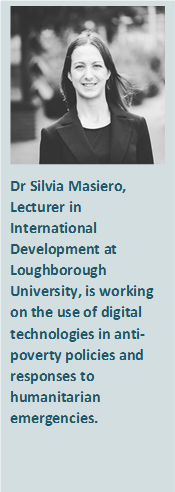 Richard Clarke, Director General for Policy, Research and Humanitarian at the UK’s Department for International Aid (DFID) announced today that a consortium involving Dr. David Hollow and Tim Unwin, both from our UNESCO Chair in ICT4D, has been awarded the contract to lead its new £20 m research and innovation hub on technology for education. This will explore how the world’s most marginalised children and young people can learn best through the use of new and innovative technologies. The members of the consortium are the Overseas Development Institute, the Research for Equitable Access and Learning (REAL) Centre at the University of Cambridge, Brink, Jigsaw Consult, Results for Development, Open Development and Education, AfriLabs, BRAC and eLearning Africa. David will serve as Research Co-Director and Tim as Chair of the Intellectual Leadership Group.
Richard Clarke, Director General for Policy, Research and Humanitarian at the UK’s Department for International Aid (DFID) announced today that a consortium involving Dr. David Hollow and Tim Unwin, both from our UNESCO Chair in ICT4D, has been awarded the contract to lead its new £20 m research and innovation hub on technology for education. This will explore how the world’s most marginalised children and young people can learn best through the use of new and innovative technologies. The members of the consortium are the Overseas Development Institute, the Research for Equitable Access and Learning (REAL) Centre at the University of Cambridge, Brink, Jigsaw Consult, Results for Development, Open Development and Education, AfriLabs, BRAC and eLearning Africa. David will serve as Research Co-Director and Tim as Chair of the Intellectual Leadership Group.
The new Hub aims to undertake and promote the highest quality of comparative and longitudinal research at the interface between technology and education, and then share the findings widely so that everyone is better aware about how technology can best serve the learning interests of the poorest and most marginalised. This builds in part on the UNESCO Chair in ICT4D’s long established experience on technology and learning, dating back to Tim’s leadership of the UK Prime Minister’s Imfundo initiative (2001-2004) creating partnerships for IT in education in Africa, our DelPHE and EDULINK funded collaboration with African universities, the wider work of the World Economic Forum and UNESCO Partnership for Education initiative between 2007 and 2011, and the cohort of PhD students doing research at the UNESCO Chair in ICT4D on technology and learning in Africa in the latter 2000s , including David Hollow and Marije Geldof.
We are all very excited to be a part of this new initiative, which will be the largest ever education and technology research and innovation programme designed specifically to improve teaching and learning, especially in poorer countries. It is a clear example of the ways through which research undertaken within the UNESCO Chair in ICT4D is having real global impact, and is the second £20 m grant to have been awarded to consortia that include members of the Chair in the last six months, the other being the UKRI GCRF South-South Migration, Inequality and Development Hub.

 On November 8, 2016, Indian Prime Minister Narendra Modi addressed the nation in a
On November 8, 2016, Indian Prime Minister Narendra Modi addressed the nation in a 


 It was great to be back in Islamabad to participate in the second two-day workshop organised by the
It was great to be back in Islamabad to participate in the second two-day workshop organised by the  Understanding the ICT4D landscape, in which the main speaker was Dr. Ismail Shah, the Chairman of the
Understanding the ICT4D landscape, in which the main speaker was Dr. Ismail Shah, the Chairman of the  Serving the most marginalised: accessibility and disability, with a plenary by
Serving the most marginalised: accessibility and disability, with a plenary by  Full details of the event can be found on the
Full details of the event can be found on the